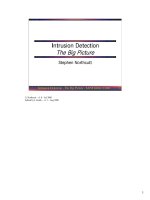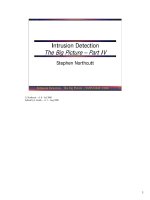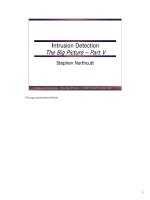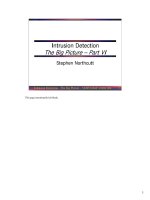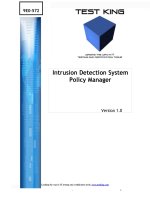Intrusion detection with snort
Bạn đang xem bản rút gọn của tài liệu. Xem và tải ngay bản đầy đủ của tài liệu tại đây (2.53 MB, 275 trang )
Intrusion Detection Systems
with Snort
Advanced IDS Techniques Using
Snort, Apache, MySQL, PHP, and ACID
B
RUCE
P
ERENS
’ O
PEN
S
OURCE
S
ERIES
◆
Managing Linux Systems with Webmin: System
Administration and Module Development
Jamie Cameron
◆
Implementing CIFS: The Common Internet File System
Christopher R. Hertel
◆
Embedded Software Development with eCos
Anthony J. Massa
◆
The Linux Development Platform: Configuring, Using,
and Maintaining a Complete Programming
Environment
Rafeeq Ur Rehman, Christopher Paul
◆
Intrusion Detection Systems with Snort:
Advanced IDS Techniques with Snort, Apache,
MySQL, PHP, and ACID
Rafeeq Ur Rehman
perens_series.fm Page 1 Thursday, April 10, 2003 1:43 AM
Intrusion Detection Systems
with Snort
Advanced IDS Techniques Using
Snort, Apache, MySQL, PHP, and ACID
Rafeeq Ur Rehman
Prentice Hall PTR
Upper Saddle River, New Jersey 07458
www.phptr.com
Library of Congress Cataloging-in-Publication Data
A CIP catalog record for this book can be obtained from the Library of Congress.
Editorial/production supervision: Mary Sudul
Cover design director: Jerry Votta
Cover design: DesignSource
Manufacturing manager: Maura Zaldivar
Acquisitions editor: Jill Harry
Editorial assistant: Noreen Regina
Marketing manager: Dan DePasquale
© 2003 Pearson Education, Inc.
Publishing as Prentice Hall PTR
Upper Saddle River, New Jersey 07458
This material may be distributed only subject to the terms and conditions set forth in the Open
Publication License, v1.0 or later (the latest version is presently available at
< />Prentice Hall books are widely used by corporations and government agencies for training, marketing,
and resale.
The publisher offers discounts on this book when ordered in bulk quantities. For more information,
contact Corporate Sales Department, Phone: 800-382-3419; FAX: 201-236-7141;
E-mail:
Or write: Prentice Hall PTR, Corporate Sales Dept., One Lake Street, Upper Saddle River, NJ 07458.
Other product or company names mentioned herein are the trademarks or registered trademarks of their
respective owners.
Printed in the United States of America
1st Printing
ISBN 0-13-140733-3
Pearson Education LTD.
Pearson Education Australia PTY, Limited
Pearson Education Singapore, Pte. Ltd.
Pearson Education North Asia Ltd.
Pearson Education Canada, Ltd.
Pearson Educación de Mexico, S.A. de C.V.
Pearson Education — Japan
Pearson Education Malaysia, Pte. Ltd.
To open source and free software developers
vii
C
ONTENTS
Chapter 1
Introduction to Intrusion Detection and Snort 1
1.1 What is Intrusion Detection? 5
1.1.1 Some Definitions 6
1.1.2 Where IDS Should be Placed in Network Topology 8
1.1.3 Honey Pots 9
1.1.4 Security Zones and Levels of Trust 10
1.2 IDS Policy 10
1.3 Components of Snort 12
1.3.1 Packet Decoder 13
1.3.2 Preprocessors 13
1.3.3 The Detection Engine 14
1.3.4 Logging and Alerting System 15
1.3.5 Output Modules 15
1.4 Dealing with Switches 16
1.5 TCP Stream Follow Up 18
1.6 Supported Platforms 18
1.7 How to Protect IDS Itself 19
1.7.1 Snort on Stealth Interface 20
1.7.2 Snort with no IP Address Interface 20
1.8 References 21
viii Contents
Chapter 2
Installing Snort and Getting Started 23
2.1 Snort Installation Scenarios 24
2.1.1 Test Installation 24
2.1.2 Single Sensor Production IDS 24
2.1.3 Single Sensor with Network Management System Integration 25
2.1.4 Single Sensor with Database and Web Interface 25
2.1.5 Multiple Snort Sensors with Centralized Database 26
2.2 Installing Snort 28
2.2.1 Installing Snort from the RPM Package 28
2.2.2 Installing Snort from Source Code 29
2.2.3 Errors While Starting Snort 43
2.2.4 Testing Snort 43
2.2.5 Running Snort on a Non-Default Interface 51
2.2.6 Automatic Startup and Shutdown 52
2.3 Running Snort on Multiple Network Interfaces 54
2.4 Snort Command Line Options 55
2.5 Step-By-Step Procedure to Compile and Install Snort
From Source Code 56
2.6 Location of Snort Files 56
2.7 Snort Modes 58
2.7.1 Network Sniffer Mode 58
2.7.2 Network Intrusion Detection Mode 65
2.8 Snort Alert Modes 66
2.8.1 Fast Mode 67
2.8.2 Full Mode 68
2.8.3 UNIX Socket Mode 68
2.8.4 No Alert Mode 69
2.8.5 Sending Alerts to Syslog 69
2.8.6 Sending Alerts to SNMP 69
2.8.7 Sending Alerts to Windows 70
2.9 Running Snort in Stealth Mode 71
2.10 References 73
Chapter 3
Working with Snort Rules 75
3.1 TCP/IP Network Layers 76
3.2 The First Bad Rule 77
3.3 CIDR 78
3.4 Structure of a Rule 79
Contents ix
3.5 Rule Headers 81
3.5.1 Rule Actions 81
3.5.2 Protocols 83
3.5.3 Address 84
3.5.4 Port Number 86
3.5.5 Direction 88
3.6 Rule Options 88
3.6.1 The ack Keyword 89
3.6.2 The classtype Keyword 89
3.6.3 The content Keyword 93
3.6.4 The offset Keyword 94
3.6.5 The depth Keyword 95
3.6.6 The content-list Keyword 95
3.6.7 The dsize Keyword 95
3.6.8 The flags Keyword 96
3.6.9 The fragbits Keyword 97
3.6.10 The icmp_id Keyword 98
3.6.11 The icmp_seq Keyword 98
3.6.12 The itype Keyword 98
3.6.13 The icode Keyword 99
3.6.14 The id Keyword 100
3.6.15 The ipopts Keyword 100
3.6.16 The ip_proto Keyword 101
3.6.17 The logto Keyword 102
3.6.18 The msg Keyword 103
3.6.19 The nocase Keyword 103
3.6.20 The priority Keyword 103
3.6.21 The react Keyword 104
3.6.22 The reference Keyword 104
3.6.23 The resp Keyword 105
3.6.24 The rev Keyword 107
3.6.25 The rpc Keyword 107
3.6.26 The sameip Keyword 108
3.6.27 The seq Keyword 108
3.6.28 The flow Keyword 108
3.6.29 The session Keyword 109
3.6.30 The sid Keyword 110
3.6.31 The tag Keyword 110
3.6.32 The tos Keyword 111
3.6.33 The ttl Keyword 111
x Contents
3.6.34 The uricontent Keyword 111
3.7 The Snort Configuration File 112
3.7.1 Using Variables in Rules 112
3.7.2 The config Directives 114
3.7.3 Preprocessor Configuration 116
3.7.4 Output Module Configuration 116
3.7.5 Defining New Action Types 117
3.7.6 Rules Configuration 117
3.7.7 Include Files 117
3.7.8 Sample snort.conf File 118
3.8 Order of Rules Based upon Action 119
3.9 Automatically Updating Snort Rules 120
3.9.1 The Simple Method 120
3.9.2 The Sophisticated and Complex Method 122
3.10 Default Snort Rules and Classes 125
3.10.1 The local.rules File 127
3.11 Sample Default Rules 127
3.11.1 Checking su Attempts from a Telnet Session 127
3.11.2 Checking for Incorrect Login on Telnet Sessions 128
3.12 Writing Good Rules 128
3.13 References 129
Chapter 4
Plugins, Preprocessors and Output Modules 131
4.1 Preprocessors 132
4.1.1 HTTP Decode 133
4.1.2 Port Scanning 134
4.1.3 The frag2 Module 135
4.1.4 The stream4 Module 136
4.1.5 The spade Module 137
4.1.6 ARP Spoofing 138
4.2 Output Modules 139
4.2.1 The alert_syslog Output Module 140
4.2.1 The alert_full Output Module 143
4.2.1 The alert_fast Output Module 143
4.2.1 The alert_smb Module 143
4.2.1 The log_tcpdump Output Module 144
4.2.1 The XML Output Module 146
4.2.1 Logging to Databases 150
4.2.1 CSV Output Module 151
Contents xi
4.2.1 Unified Logging Output Module 153
4.2.1 SNMP Traps Output Module 154
4.2.1 Log Null Output Module 155
4.3 Using BPF Fileters 155
4.4 References 156
Chapter 5
Using Snort with MySQL 157
5.1 Making Snort Work with MySQL 160
5.1.1 Step 1: Snort Compilations with MySQL Support 161
5.1.1 Step 2: Install MySQL 161
5.1.1 Step 3: Creating Snort Database in MySQL 161
5.1.1 Step 4: Creating MySQL User and Granting
Permissions to User and Setting Password 163
5.1.1 Step 5: Creating Tables in the Snort Database 164
5.1.1 Step 6: Modify snort.conf Configuration File 170
5.1.1 Step 7: Starting Snort with Database Support 171
5.1.1 Step 8: Logging to Database 172
5.2 Secure Logging to Remote Databases Securely
Using Stunnel 174
5.3 Snort Database Maintenance 175
5.3.1 Archiving the Database 175
5.3.2 Using Sledge Hammer: Drop the Database 176
5.4 References 176
Chapter 6
Using ACID and SnortSnarf with Snort 177
6.1 What is ACID? 178
6.2 Installation and Configuration 179
6.3 Using ACID 184
6.3.1 ACID Main Page 188
6.3.2 Listing Protocol Data 189
6.3.3 Alert Details 191
6.3.4 Searching 192
6.3.5 Searching whois Databases 197
6.3.6 Generating Graphs 198
6.3.7 Archiving Snort Data 198
6.3.8 ACID Tables 201
6.4 SnortSnarf 202
6.5 Barnyard 207
6.6 References 207
xii Contents
Chapter 7
Miscellaneous Tools 209
7.1 SnortSam 210
7.2 IDS Policy Manager 212
7.3 Securing the ACID Web Console 217
7.3.1 Using a Private Network 217
7.3.2 Blocking Access to the Web Server on the Firewall 218
7.3.3 Using iptables 218
7.4 Easy IDS 218
7.5 References 219
Appendix A
Introduction to tcpdump 221
Appendix B
Getting Started with MySQL 223
Appendix C
Packet Header Formats 237
Appendix D
Glossary 243
Appendix E
SNML DTD 245
Index 251
1
C
HAPTER
1
Introduction to
Intrusion Detection
and Snort
ecurity is a big issue for all networks in today’s enterprise environ-
ment. Hackers and intruders have made many successful attempts to
bring down high-profile company networks and web services. Many
methods have been developed to secure the network infrastructure and
communication over the Internet, among them the use of firewalls,
encryption, and virtual private networks. Intrusion detection is a relatively
new addition to such techniques. Intrusion detection methods started
appearing in the last few years. Using intrusion detection methods, you
can collect and use information from known types of attacks and find out
if someone is trying to attack your network or particular hosts. The infor-
mation collected this way can be used to harden your network security, as
well as for legal purposes. Both commercial and open source products are
now available for this purpose. Many vulnerability assessment tools are
also available in the market that can be used to assess different types of
security holes present in your network. A comprehensive security system
consists of multiple tools, including:
• Firewalls that are used to block unwanted incoming as well as outgo-
ing traffic of data. There is a range of firewall products available in
the market both in Open Source and commercial products. Most pop-
ular commercial firewall products are from Checkpoint (http://
www.checkpoint.com), Cisco () and Netscreen
S
2 Chapter 1 • Introduction to Intrusion Detection and Snort
(). The most popular Open Source firewall
is the Netfilter/Iptables ()-based firewall.
• Intrusion detection systems (IDS) that are used to find out if someone
has gotten into or is trying to get into your network. The most popular
IDS is Snort, which is available at .
• Vulnerability assessment tools that are used to find and plug security
holes present in your network. Information collected from vulnerability
assessment tools is used to set rules on firewalls so that these security
holes are safeguarded from malicious Internet users. There are many
vulnerability assessment tools including Nmap ()
and Nessus ().
These tools can work together and exchange information with each other. Some
products provide complete systems consisting of all of these products bundled together.
Snort is an open source Network Intrusion Detection System (NIDS) which is
available free of cost. NIDS is the type of Intrusion Detection System (IDS) that is used
for scanning data flowing on the network. There are also host-based intrusion detection
systems, which are installed on a particular host and detect attacks targeted to that host
only. Although all intrusion detection methods are still new, Snort is ranked among the
top quality systems available today.
The book starts with an introduction to intrusion detection and related terminology.
You will learn installation and management of Snort as well as other products that work
with Snort. These products include MySQL database () and Analy-
sis Control for Intrusion Database (ACID) ( Snort has the
capability to log data collected (such as alerts and other log messages) to a database.
MySQL is used as the database engine where all of this data is stored. Using Apache
web server () and ACID, you can analyze this data. A combina-
tion of Snort, Apache, MySQL, and ACID makes it possible to log the intrusion detec-
tion data into a database and then view and analyze it later, using a web interface.
This book is organized in such a way that the reader will be able to build a com-
plete intrusion detection system by going through the following chapters in a step-by-
step manner. All steps of installing and integrating different tools are explained in the
book as outlined below.
Chapter 2 provides basic information about how to build and install Snort itself.
Using the basic installation and default rules, you will be able to get a working IDS.
You will be able to create log files that show intrusion activity.
Chapter 3 provides information about Snort rules, different parts of Snort rules
and how to write your own rules according to your environment and needs. This chapter
3
is very important, as writing good rules is the key to building a detection system. The
chapter also explains different rules that are part of Snort distribution.
Chapter 4 is about input and output plug-ins. Plug-ins are parts of the software
that are compiled with Snort and are used to modify input or output of the Snort detec-
tion engine. Input plug-ins prepare captured data packets before the actual detection
process is applied on these packets. Output plug-ins format output to be used for a par-
ticular purpose. For example, an output plug-in can convert the detection data to a Sim-
ple Network Management Protocol (SNMP) trap. Another output plug-in is used to log
Snort output data into databases. This chapter provides a comprehensive overview of
how these plug-ins are configured and used.
Chapter 5 provides information about using MySQL database with Snort. MySQL
plug-in enables Snort to log data into the database to be used in the analysis later on. In
this chapter you will find information about how to create a database in MySQL, con-
figure a database plug-in, and log data to the database.
Chapter 6 describes ACID, how to use it to get data from the database you config-
ured in Chapter 5, and how to display it using Apache web server. ACID is a very
important tool that provides rich data analysis capabilities. You can find frequency of
attacks, classify different attacks, view the source of these attacks and so on. ACID uses
PHP (Pretty Home Page) scripting language, graphic display library (GD library) and
PHPLOT, which is a tool to draw graphs. A combination of all of these results in web
pages that display, analyze and graph data stored in the MySQL database.
Chapter 7 is devoted to information about some other useful tools that can be used
with Snort.
The system that you will build after going through this book is displayed in Figure
1-1 with different components.
As you can see, data is captured and analyzed by Snort. Snort then stores this data
in the MySQL database using the database output plug-in. Apache web server takes help
from ACID, PHP, GD library and PHPLOT package to display this data in a browser
window when a user connects to Apache. A user can then make different types of queries
on the forms displayed in the web pages to analyze, archive, graph and delete data.
In essence, you can build a single computer with Snort, MySQL database,
Apache, PHP, ACID, GD library and PHPLOT. A more realistic picture of the system
that you will be able to build after reading this book is shown in Figure 1-2.
In the enterprise, usually people have multiple Snort sensors behind every router
or firewall. In that case you can use a single centralized database to collect data from all
of the sensors. You can run Apache web server on this centralized database server as
shown in Figure 1-3.
4 Chapter 1 • Introduction to Intrusion Detection and Snort
Figure 1-1 Block diagram of a complete network intrusion detection system
consisting of Snort, MySQL, Apache, ACID, PHP, GD Library and PHPLOT.
Figure 1-2 A network intrusion detection system with web interface.
What is Intrusion Detection? 5
1.1 What is Intrusion Detection?
Intrusion detection is a set of techniques and methods that are used to detect suspi-
cious activity both at the network and host level. Intrusion detection systems fall into
two basic categories: signature-based intrusion detection systems and anomaly detec-
tion systems. Intruders have signatures, like computer viruses, that can be detected
using software. You try to find data packets that contain any known intrusion-related
signatures or anomalies related to Internet protocols. Based upon a set of signatures
and rules, the detection system is able to find and log suspicious activity and generate
alerts. Anomaly-based intrusion detection usually depends on packet anomalies
present in protocol header parts. In some cases these methods produce better results
compared to signature-based IDS. Usually an intrusion detection system captures
data from the network and applies its rules to that data or detects anomalies in it.
Snort is primarily a rule-based IDS, however input plug-ins are present to detect
anomalies in protocol headers.
Figure 1-3 Multiple Snort sensors in the enterprise logging to a centralized database server.
6 Chapter 1 • Introduction to Intrusion Detection and Snort
Snort uses rules stored in text files that can be modified by a text editor. Rules are
grouped in categories. Rules belonging to each category are stored in separate files.
These files are then included in a main configuration file called snort.conf. Snort reads
these rules at the start-up time and builds internal data structures or chains to apply
these rules to captured data. Finding signatures and using them in rules is a tricky job,
since the more rules you use, the more processing power is required to process captured
data in real time. It is important to implement as many signatures as you can using as
few rules as possible. Snort comes with a rich set of pre-defined rules to detect intrusion
activity and you are free to add your own rules at will. You can also remove some of the
built-in rules to avoid false alarms.
1.1.1 Some Definitions
Before we go into details of intrusion detection and Snort, you need to learn some
definitions related to security. These definitions will be used in this book repeatedly in
the coming chapters. A basic understanding of these terms is necessary to digest other
complicated security concepts.
1.1.1.1 IDS
Intrusion Detection System or IDS is software, hardware or combination of both
used to detect intruder activity. Snort is an open source IDS available to the general
public. An IDS may have different capabilities depending upon how complex and
sophisticated the components are. IDS appliances that are a combination of hardware
and software are available from many companies. As mentioned earlier, an IDS may
use signatures, anomaly-based techniques or both.
1.1.1.2 Network IDS or NIDS
NIDS are intrusion detection systems that capture data packets traveling on the
network media (cables, wireless) and match them to a database of signatures. Depend-
ing upon whether a packet is matched with an intruder signature, an alert is generated or
the packet is logged to a file or database. One major use of Snort is as a NIDS.
1.1.1.3 Host IDS or HIDS
Host-based intrusion detection systems or HIDS are installed as agents on a host.
These intrusion detection systems can look into system and application log files to
detect any intruder activity. Some of these systems are reactive, meaning that they
inform you only when something has happened. Some HIDS are proactive; they can
sniff the network traffic coming to a particular host on which the HIDS is installed and
alert you in real time.
What is Intrusion Detection? 7
1.1.1.4 Signatures
Signature is the pattern that you look for inside a data packet. A signature is used
to detect one or multiple types of attacks. For example, the presence of “scripts/iisad-
min” in a packet going to your web server may indicate an intruder activity.
Signatures may be present in different parts of a data packet depending upon the
nature of the attack. For example, you can find signatures in the IP header, transport
layer header (TCP or UDP header) and/or application layer header or payload. You will
learn more about signatures later in this book.
Usually IDS depends upon signatures to find out about intruder activity. Some
vendor-specific IDS need updates from the vendor to add new signatures when a new
type of attack is discovered. In other IDS, like Snort, you can update signatures your-
self.
1.1.1.5 Alerts
Alerts are any sort of user notification of an intruder activity. When an IDS detects
an intruder, it has to inform security administrator about this using alerts. Alerts may be
in the form of pop-up windows, logging to a console, sending e-mail and so on. Alerts
are also stored in log files or databases where they can be viewed later on by security
experts. You will find detailed information about alerts later in this book.
Snort can generate alerts in many forms and are controlled by output plug-ins.
Snort can also send the same alert to multiple destinations. For example, it is possible to
log alerts into a database and generate SNMP traps simultaneously. Some plug-ins can
also modify firewall configuration so that offending hosts are blocked at the firewall or
router level.
1.1.1.6 Logs
The log messages are usually saved in file. By default Snort saves these messages
under /var/log/snort directory. However, the location of log messages can be changed
using the command line switch when starting Snort. Log messages can be saved either
in text or binary format. The binary files can be viewed later on using Snort or tcpdump
program. A new tool called Barnyard is also available now to analyze binary log files
generated by Snort. Logging in binary format is faster because it saves some formatting
overhead. In high-speed Snort implementations, logging in binary mode is necessary.
1.1.1.7 False Alarms
False alarms are alerts generated due to an indication that is not an intruder activ-
ity. For example, misconfigured internal hosts may sometimes broadcast messages that
trigger a rule resulting in generation of a false alert. Some routers, like Linksys home
routers, generate lots of UPnP related alerts. To avoid false alarms, you have to modify
8 Chapter 1 • Introduction to Intrusion Detection and Snort
and tune different default rules. In some cases you may need to disable some of the
rules to avoid false alarms.
1.1.1.8 Sensor
The machine on which an intrusion detection system is running is also called the
sensor in the literature because it is used to “sense” the network. Later in this book if the
word sensor is used, it refers to a computer or other device where Snort is running.
1.1.2 Where IDS Should be Placed in Network Topology
Depending upon your network topology, you may want to position intrusion
detection systems at one or more places. It also depends upon what type of intrusion
activities you want to detect: internal, external or both. For example, if you want to
detect only external intrusion activities, and you have only one router connecting to the
Internet, the best place for an intrusion detection system may be just inside the router or
a firewall. If you have multiple paths to the Internet, you may want to place one IDS
box at every entry point. However if you want to detect internal threats as well, you may
want to place a box in every network segment.
In many cases you don’t need to have intrusion detection activity in all network
segments and you may want to limit it only to sensitive network areas. Note that more
intrusion detection systems mean more work and more maintenance costs. Your deci-
sion really depends upon your security policy, which defines what you really want to
protect from hackers. Figure 1-4 shows typical locations where you can place an intru-
sion detection system.
Figure 1-4 Typical locations for an intrusion detection system.
What is Intrusion Detection? 9
As you can see from Figure 1-4, typically you should place an IDS behind each of
your firewalls and routers. In case your network contains a demilitarized zone (DMZ),
an IDS may be placed in that zone as well. However alert generation policy should not
be as strict in a DMZ compared to private parts of the network.
1.1.3 Honey Pots
Honey pots are systems used to lure hackers by exposing known vulnerabilities
deliberately. Once a hacker finds a honey pot, it is more likely that the hacker will stick
around for some time. During this time you can log hacker activities to find out his/her
actions and techniques. Once you know these techniques, you can use this information
later on to harden security on your actual servers.
There are different ways to build and place honey pots. The honey pot should have
common services running on it. These common services include Telnet server (port 23),
Hyper Text Transfer Protocol (HTTP) server (port 80), File Transfer Protocol (FTP)
server (port 21) and so on. You should place the honey pot somewhere close to your
production server so that the hackers can easily take it for a real server. For example, if
your production servers have Internet Protocol (IP) addresses 192.168.10.21 and
192.168.10.23, you can assign an IP address of 192.168.10.22 to the honey pot. You can
also configure your firewall and/or router to redirect traffic on some ports to a honey pot
where the intruder thinks that he/she is connecting to a real server. You should be care-
ful in creating an alert mechanism so that when your honey pot is compromised, you are
notified immediately. It is a good idea to keep log files on some other machine so that
when the honey pot is compromised, the hacker does not have the ability to delete these
files.
So when should you install a honey pot? The answer depends on different criteria,
including the following:
• You should create a honey pot if your organization has enough resources to
track down hackers. These resources include both hardware and personnel. If
you don’t have these resources, there is no need to install a honey pot. After all,
there is no need to have data if you can’t use it.
• A honey pot is useful only if you want to use the information gathered in some
way.
• You may also use a honey pot if you want to prosecute hackers by gathering
evidence of their activities.
10 Chapter 1 • Introduction to Intrusion Detection and Snort
Ideally a honey pot should look like a real system. You should create some fake
data files, user accounts and so on to ensure a hacker that this is a real system. This will
tempt the hacker to remain on the honey pot for a longer time and you will be able to
record more activity.
To have more information and get a closer look at honey pots, go to the Honey Pot
Project web site where you will find interesting material.
Also go to the Honeyd web site at to find
out information about this open source honey pot. Some other places where you can
find more information are:
• South Florida Honeynet Project at
• Different HOWTOs at />1.1.4 Security Zones and Levels of Trust
Some time ago people divided networks into two broad areas, secure area and
unsecure area. Sometimes this division also meant a network is inside a firewall or a
router and outside your router. Now typical networks are divided into many different
areas and each area may have a different level of security policy and level of trust. For
example, a company’s finance department may have a very high security level and may
allow only a few services to operate in that area. No Internet service may be available
from the finance department. However a DMZ or de-militarized zone part of your net-
work may be open to the Internet world and may have a very different level of trust.
Depending upon the level of trust and your security policy, you should also have
different policies and rules for intruder detection in different areas of your network.
Network segments with different security requirements and trust levels are kept physi-
cally separate from each other. You can install one intrusion detection system in each
zone with different types of rules to detect suspicious network activity. As an example,
if your finance department has no web server, any traffic going to port 80 in the finance
department segment may come under scrutiny for intruder activity. The same is not true
in the DMZ zone where you are running a company web server accessible to everyone.
1.2 IDS Policy
Before you install the intrusion detection system on your network, you must have a pol-
icy to detect intruders and take action when you find such activity. A policy must dictate
IDS rules and how they will be applied. The IDS policy should contain the following
components; you can add more depending upon your requirements.
IDS Policy 11
• Who will monitor the IDS? Depending on the IDS, you may have alerting
mechanisms that provide information about intruder activity. These alerting
systems may be in the form of simple text files, or they may be more
complicated, perhaps integrated to centralized network management systems
like HP OpenView or MySQL database. Someone is needed to monitor the
intruder activity and the policy must define the responsible person(s). The
intruder activity may also be monitored in real time using pop-up windows or
web interfaces. In this case operators must have knowledge of alerts and their
meaning in terms of severity levels.
• Who will administer the IDS, rotate logs and so on? As with all systems, you
need to establish routine maintenance of the IDS.
• Who will handle incidents and how? If there is no incident handling, there is no
point in installing an IDS. Depending upon the severity of the incident, you
may need to get some government agencies involved.
• What will be the escalation process (level 1, level 2 and so on)? The escalation
process is basically an incident response strategy. The policy should clearly
describe which incidents should be escalated to higher management.
• Reporting. Reports may be generated showing what happened during the last
day, week or month.
• Signature updates. Hackers are continuously creating new types of attacks.
These attacks are detected by the IDS if it knows about the attack in the form of
signatures. Attack signatures are used in Snort rules to detect attacks. Because
of the continuously changing nature of attacks, you must update signatures and
rules on your IDS. You can update signatures directly from the Snort web site
on a periodic basis or on your own when a new threat is discovered.
• Documentation is required for every project. The IDS policy should describe
what type of documentation will be done when attacks are detected. The
documentation may include a simple log or record of complete intruder
activity. You may also need to build some forms to record data. Reports are also
part of regular documentation.
Based on the IDS policy you will get a clear idea of how many IDS sensors and
other resources are required for your network. With this information, you will be able to
calculate the cost of ownership of IDS more precisely.
12 Chapter 1 • Introduction to Intrusion Detection and Snort
1.3 Components of Snort
Snort is logically divided into multiple components. These components work together
to detect particular attacks and to generate output in a required format from the detec-
tion system. A Snort-based IDS consists of the following major components:
• Packet Decoder
• Preprocessors
• Detection Engine
• Logging and Alerting System
• Output Modules
Figure 1-5 shows how these components are arranged. Any data packet coming
from the Internet enters the packet decoder. On its way towards the output modules, it is
either dropped, logged or an alert is generated.
Figure 1-5 Components of Snort.
Components of Snort 13
A brief introduction to these components is presented in this section. As you go
through the book and create some rules, you will become more familiar with these com-
ponents and how they interact with each other.
1.3.1 Packet Decoder
The packet decoder takes packets from different types of network interfaces and
prepares the packets to be preprocessed or to be sent to the detection engine. The inter-
faces may be Ethernet, SLIP, PPP and so on.
1.3.2 Preprocessors
Preprocessors are components or plug-ins that can be used with Snort to arrange
or modify data packets before the detection engine does some operation to find out if
the packet is being used by an intruder. Some preprocessors also perform detection by
finding anomalies in packet headers and generating alerts. Preprocessors are very
important for any IDS to prepare data packets to be analyzed against rules in the detec-
tion engine. Hackers use different techniques to fool an IDS in different ways. For
example, you may have created a rule to find a signature “scripts/iisadmin” in HTTP
packets. If you are matching this string exactly, you can easily be fooled by a hacker
who makes slight modifications to this string. For example:
• “scripts/./iisadmin”
• “scripts/examples/ /iisadmin”
• “scripts\iisadmin”
• “scripts/.\iisadmin”
To complicate the situation, hackers can also insert in the web Uniform Resource
Identifier (URI) hexadecimal characters or Unicode characters which are perfectly legal
as far as the web server is concerned. Note that the web servers usually understand all
of these strings and are able to preprocess them to extract the intended string “scripts/
iisadmin”. However if the IDS is looking for an exact match, it is not able to detect this
attack. A preprocessor can rearrange the string so that it is detectable by the IDS.
Preprocessors are also used for packet defragmentation. When a large data chunk
is transferred to a host, the packet is usually fragmented. For example, default maxi-
mum length of any data packet on an Ethernet network is usually 1500 bytes. This value
is controlled by the Maximum Transfer Unit (MTU) value for the network interface.
This means that if you send data which is more than 1500 bytes, it will be split into mul-
tiple data packets so that each packet fragment is less than or equal to 1500 bytes. The

